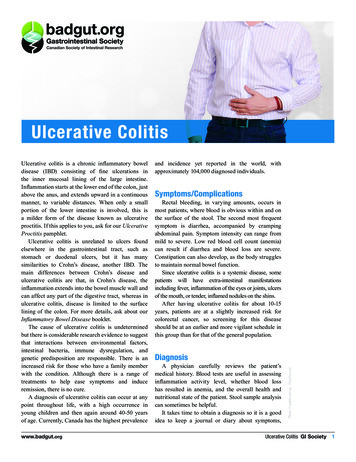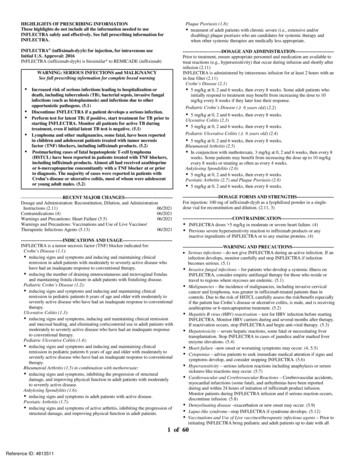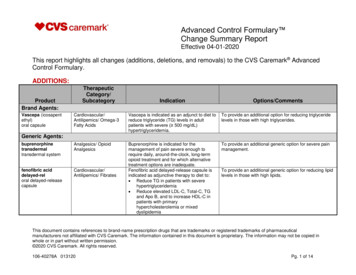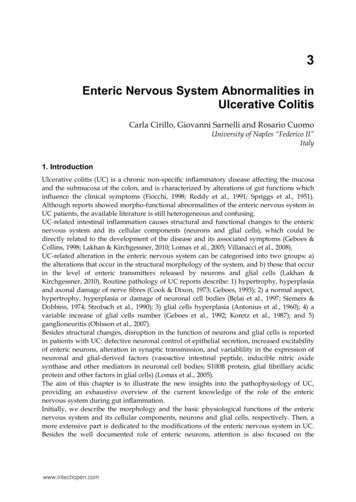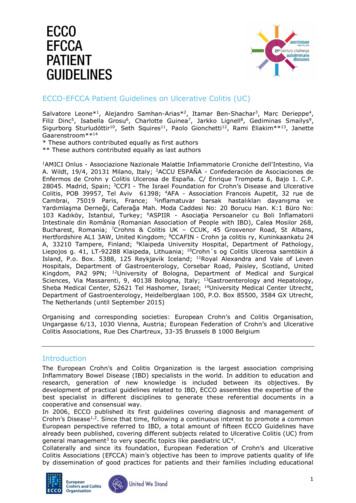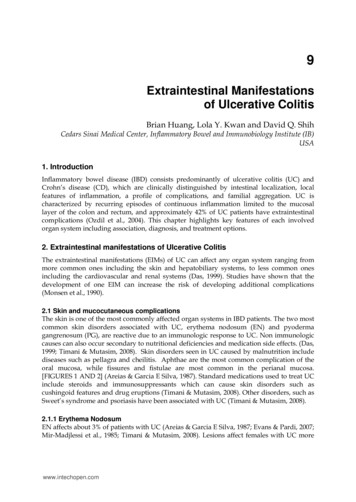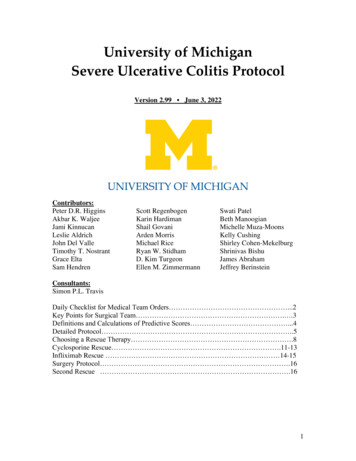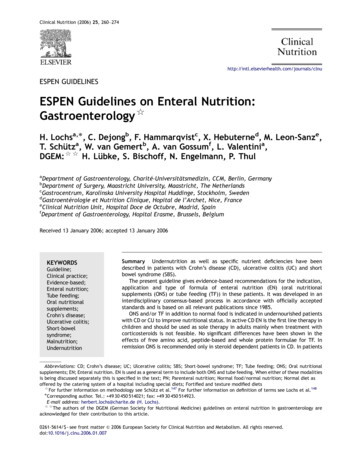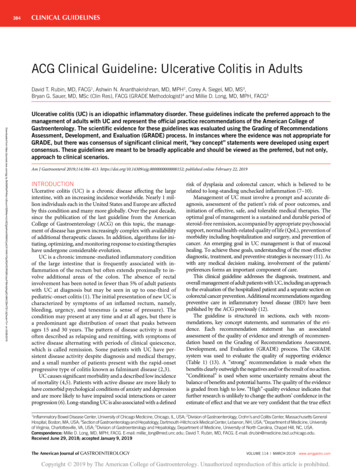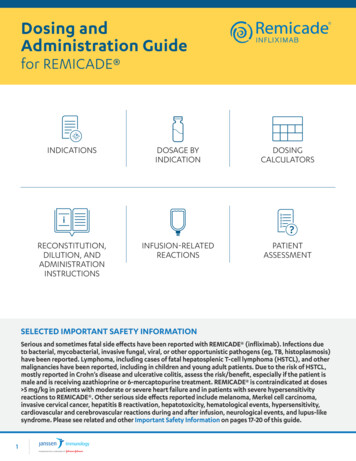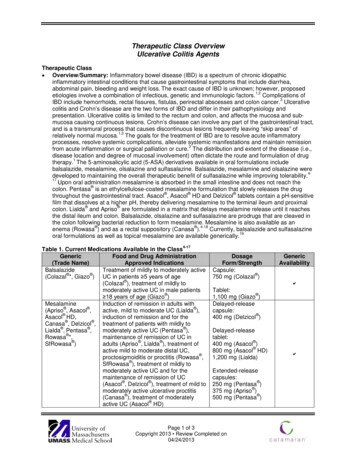
Transcription
Therapeutic Class OverviewUlcerative Colitis AgentsTherapeutic Class Overview/Summary: Inflammatory bowel disease (IBD) is a spectrum of chronic idiopathicinflammatory intestinal conditions that cause gastrointestinal symptoms that include diarrhea,abdominal pain, bleeding and weight loss. The exact cause of IBD is unknown; however, proposed1,2etiologies involve a combination of infectious, genetic and immunologic factors. Complications of3IBD include hemorrhoids, rectal fissures, fistulas, perirectal abscesses and colon cancer. Ulcerativecolitis and Crohn’s disease are the two forms of IBD and differ in their pathophysiology andpresentation. Ulcerative colitis is limited to the rectum and colon, and affects the mucosa and submucosa causing continuous lesions. Crohn’s disease can involve any part of the gastrointestinal tract,and is a transmural process that causes discontinuous lesions frequently leaving “skip areas” of1,3relatively normal mucosa. The goals for the treatment of IBD are to resolve acute inflammatoryprocesses, resolve systemic complications, alleviate systemic manifestations and maintain remission3from acute inflammation or surgical palliation or cure. The distribution and extent of the disease (i.e.,disease location and degree of mucosal involvement) often dictate the route and formulation of drug1therapy. The 5-aminosalicylic acid (5-ASA) derivatives available in oral formulations includebalsalazide, mesalamine, olsalazine and sulfasalazine. Balsalazide, mesalamine and olsalazine were4developed to maintaining the overall therapeutic benefit of sulfasalazine while improving tolerability.17Upon oral administration mesalamine is absorbed in the small intestine and does not reach the colon. Pentasa is an ethylcellulose-coated mesalamine formulation that slowly releases the drug throughout the gastrointestinal tract. Asacol , Asacol HD and Delzicol tablets contain a pH-sensitivefilm that dissolves at a higher pH, thereby delivering mesalamine to the terminal ileum and proximal colon. Lialda and Apriso are formulated in a matrix that delays mesalamine release until it reachesthe distal ileum and colon. Balsalazide, olsalazine and sulfasalazine are prodrugs that are cleaved inthe colon following bacterial reduction to form mesalamine. Mesalamine is also available as an 4-18Currently, balsalazide and sulfasalazineenema (Rowasa ) and as a rectal suppository (Canasa ).19oral formulations as well as topical mesalamine are available generically.4-17Table 1. Current Medications Available in the ClassGenericFood and Drug Administration(Trade Name)Approved IndicationsTreatment of mildly to moderately activeBalsalazide (Colazal *, Giazo ) UC in patients 5 years of age (Colazal ), treatment of mildly tomoderately active UC in male patients 18 years of age (Giazo )MesalamineInduction of remission in adults with (Apriso , Asacol ,active, mild to moderate UC (Lialda ), Asacol HD,induction of remission and for the Canasa , Delzicol , treatment of patients with mildly to Lialda , Pentasa ,moderately active UC (Pentasa ), Rowasa *,maintenance of remission of UC in SfRowasa )adults (Apriso , Lialda ), treatment ofactive mild to moderate distal UC, proctosigmoiditis or proctitis (Rowasa , SfRowasa ), treatment of mildly tomoderately active UC and for themaintenance of remission of UC (Asacol , Delzicol ), treatment of mild tomoderately active ulcerative proctitis (Canasa ), treatment of moderately active UC (Asacol HD)DosageForm/StrengthCapsule: 750 mg (Colazal )GenericAvailability Tablet: 1,100 mg (Giazo )Delayed-releasecapsule: 400 mg (Delzicol )Delayed-releasetablet: 400 mg (Asacol ) 800 mg (Asacol HD)1,200 mg (Lialda)Extended-releasecapsules: 250 mg (Pentasa ) 375 mg (Apriso ) 500 mg (Pentasa )Page 1 of 3Copyright 2013 Review Completed on04/24/2013
Therapeutic Class Overview: ulcerative colitis agentsGeneric(Trade Name)Olsalazine (Dipentum )Sulfasalazine (Azulfidine *,Azulfidine EN Tabs *)Food and Drug AdministrationApproved IndicationsMaintenance of remission of UC inpatients who are intolerant ofsulfasalazineProlongation of the remission periodbetween acute attacks of UC (Azulfidine , Azulfidine EN-tabs ),treatment of mild to moderate UC, andas adjunctive therapy in severe UC (Azulfidine , Azulfidine EN-tabs ),Treatment of pediatric patients withpolyarticular-course juvenile rheumatoidarthritis who have respondedinadequately to salicylates or other NSAIDs, (Azulfidine EN-tabs ) andtreatment of patients with rheumatoidarthritis who have respondedinadequately to salicylates or otherNSAIDs [e.g., an insufficient therapeuticresponse to, or intolerance of, anadequate trial of full doses of one or more NSAIDs] (Azulfidine EN-tabs )DosageForm/StrengthRectal enema:4,000 mg/60 mL unit (Rowasa ; SfRowasa )Rectal suppository: 1,000 mg (Canasa )Capsule: 250 mg (Dipentum )GenericAvailability-Delayed-releasetablet:500 mg (Azulfidine EN-tab )Tablet: 500 mg (Azulfidine ) NSAIDs nonsteroidal anti-inflammatory drugs, UC ulcerative colitis*Generic available in at least one dosage form or strength.Evidence-based Medicine A Cochrane review of the 5-aminosalicylic acid (5-ASA) derivative oral preparations for the inductionof remission in patients with ulcerative colitis, demonstrates that newer 5-ASA derivatives aresignificantly more effective compared to placebo with no statistically significant differences between205-ASA preparations. Results from a meta-analysis comparing mesalamine once daily to multiple daily dosingdemonstrated that once-daily dosing is as effective and has a comparable safety profile as multipledosing regimens for the maintenance treatment of ulcerative colitis. In addition, once-daily dosing is21more effective for inducing remission in active ulcerative colitis compared to multiple daily dosing. Oral sulfasalazine therapy has been shown to be less effective than rectal mesalamine therapy in22patients with distal ulcerative colitis. In another meta-analysis, rectal 5-ASA was significantly more effective compared to placebo andrectal corticosteroids for inducing remission in ulcerative colitis. Rectal 5-ASA was not more effective23compared to oral 5-ASA for symptomatic improvement. A meta-analysis that evaluated the efficacy of topical mesalamine concluded that topical mesalamineis more effective compared to placebo for the prevention of relapse of disease activity in quiescentulcerative colitis. The time to relapse was longer with topical mesalamine in the two trials thatreported this outcome, and there was a trend toward a greater effect size with continuous topical24therapy compared to intermittent therapy. In a meta-analysis evaluating the efficacy of oral 5-ASA therapy compared to topical 5-ASA therapyor a combination of oral and topical 5-ASA therapy, combined 5-ASA therapy was more effectivecompared to oral 5-ASA therapy for induction of remission in mild to moderately active ulcerativePage 2 of 3Copyright 2013 Review Completed on04/24/2013
Therapeutic Class Overview: ulcerative colitis agentscolitis. Moreover, intermittent topical 5-ASA therapy was more effective compared to oral 5-ASA25therapy for preventing relapse of quiescent ulcerative colitis.Key Points within the Medication Class According to Current Clinical Guidelines:oAccording to current guidelines by the American College of Gastroenterology, oralaminosalicylates (balsalazide, mesalamine, olsalazine and sulfasalazine) are effective for26achieving and maintaining remission in distal disease.oTopical mesalamine formulations are more effective than topical steroids or oralaminosalicylates; however, the combination of oral and topical agents more effective26compared to each agent alone.oBalsalazide, mesalamine and sulfasalazine are effective in maintaining remission of disease,26and combination oral and topical therapy is better than oral mesalamine alone.oSulfasalazine is recognized as a first-line agent in the management of mild to moderatelyactive colitis, with balsalazide, mesalamine, olsalazine being effective for reducing the26number of relapses and the maintenance of mild to moderate disease remission. Other Key Facts:19o Balsalazide and sulfasalazine oral formulations are available generically.19o Topical mesalamine enemas are available generically.References1. Hemstreet BA, Dipiro JT. Inflammatory Bowel Disease. In: DiPiro JT, Talbert RL, Yee GC, Matzke GR, Wells BG, Posey LM,editors. Pharmacotherapy: A Pathophysiologic Approach. 8th Edition. New York: McGraw-Hill; 2011. p. 295-335.2. Wallace JL, Sharkey KA. Pharmacotherapy of Inflammatory Bowel Disease in Goodman and Gilman’s The PharmacologicalBasis of Therapeutics. 12th Edition. New York: McGraw-Hill; 2011.3. Peppercorn MA. Definition, epidemiology, and risk factors in inflammatory bowel disease. In: Basow DS (Ed). UpToDate[database on the internet]. Waltham (MA): UpToDate; 2013 [cited 2013 Apr 19]. Available at: http://www.utdol.com/utd/index.do.4. Apriso [package insert]. Salix Pharmaceuticals, Inc.; Raleigh (NC): 2009 July.5. Asacol [package insert]. Warner Chilcott (US), LLC; Rockaway (NJ): 2011 Jan.6. Asacol HD [package insert]. Warner Chilcott (US), LLC; Rockaway (NJ): 2010 Oct.7. Canasa [package insert]. Axcan Pharma Inc.; Birmingham (AL): 2008 Oct.8. Delzicol [package insert]. Warner Chilcott, LLC; Rockaway (NJ): 2013 Feb.9. Lialda [package insert]. Shire US, Inc.; Wayne (PA): 2011 July.10. Pentasa [package insert]. Shire US, Inc.; Wayne (PA): 2012 April.11. Rowasa [package insert]. Alaven Pharmaceutical, LLC; Marietta (GA): 2008 Aug.12. sfRowasa [package insert]. Alaven Pharmaceutical, LLC; Marietta (GA): 2008 June.13. Azulfidine [package insert]. Pfizer; New York (NY): 2011 Sept.14. Azulfidine EN-tabs [package insert]. Pfizer; New York (NY): 2011 Sept.15. Colazal [package insert]. Salix Pharmaceuticals, Inc.; Raleigh (NC): 2008 May.16. Giazo [package insert]. Salix Pharmaceuticals, Inc.; Raleigh (NC): 2012 Feb.17. Dipentum [package insert]. Alaven Pharmaceutical, LLC; Marietta (GA): 2009 Feb.18. [No authors listed]. Drugs for inflammatory bowel disease. Treat Guidel Med Lett. 2012 Mar;10(115):19-28.19. Drugs@FDA [database on the Internet]. Rockville (MD): Food and Drug Administration (US), Center for Drug Evaluation andResearch; 2013 [cited 2013 Apr 19]. Available from: fda/index.cfm.20. Feagan BG, Macdonald JK. Oral 5-aminosalicylic acid for induction of remission in ulcerative colitis. Cochrane Database SystRev 2012; 10:CD000543.21. Tong JL, Huang ML, Xu XT, Qiau YQ, Ran ZH. Once-daily vs multiple-daily mesalamine for patients with ulcerative colitis: ameta-analysis. Journal of Digestive Diseases. 2012;13:200-7.22. Kam L, Cohen H, Dooley C, Rubin P, Orchard J. A comparison of mesalamine suspension enema and oral sulfasalazine fortreatment of active distal ulcerative colitis in adults. Am J Gastroenterol. 1996 Jul;91(7):1338-42.23. Marshall JK, Thabane M, Steinhart AH, Newman JR, Anand A, Irvine EJ. Rectal 5-aminosalicylic acid for induction of remission inulcerative colitis. Cochrane Database Syst Rev. 2010 Jan 20;(1):CD004115.24. Ford AC, Khan KJ, Sandborn WJ, Hanauer SB, Moayyedi P. Efficacy of topical 5-aminosalicylates in preventing relapse ofquiescent ulcerative colitis: a meta-analysis. Clinical Gastroenterology and Hepatology. 2012;10:513-9.25. Ford AC, Khan KJ, Achkar JP, Moayyedi P. Efficacy of oral vs topical, or combined oral and topical 5-aminosalicylates, inulcerative colitis: Systematic review and meta-analysis. Am J Gastroenterol. 2012;107:167-76.26. Kornbluth A, Sachar DB; Practice Parameters Committee of the American College of Gastroenterology. Ulcerative colitis practiceguidelines in adults: American College Of Gastroenterology, Practice Parameters Committee. Am J Gastroenterol. 2010Mar;105(3):501-23.Page 3 of 3Copyright 2013 Review Completed on04/24/2013
Therapeutic Class ReviewUlcerative Colitis AgentsOverview/SummaryInflammatory bowel disease (IBD) is a spectrum of chronic idiopathic inflammatory intestinal conditionsthat cause gastrointestinal symptoms including diarrhea, abdominal pain, bleeding and weight loss. Theexact cause of IBD is unknown; however, proposed etiologies involve a combination of infectious, genetic1,2and immunologic factors. Complications of IBD include hemorrhoids, rectal fissures, fistulas, perirectalabscesses and colon cancer. Ulcerative colitis and Crohn’s disease are the two forms of IBD and differ in3their pathophysiology. As a result, the approach to the treatment of each condition may differ. Ulcerativecolitis is limited to the rectum and colon and generally affects the mucosa and sub-mucosa causingcontinuous lesions. Crohn’s disease can involve any part of the gastrointestinal tract, and is a transmural1,3process that causes discontinuous lesions frequently leaving “skip areas” of relatively normal mucosa.Ulcerative colitis almost always involves the rectum and may extend in a proximal and continuous fashionto involve other portions of the colon. Ulcerative proctitis refers to disease limited to the rectum. Ulcerativeproctosigmoiditis refers to disease limited to the rectum and sigmoid colon and not involving thedescending colon. Left-sided or distal ulcerative colitis is defined as disease that extends beyond therectum and as far proximally as the splenic flexure. Extensive colitis refers to disease extending proximalto the splenic flexure but sparing the cecum. Pancolitis is used when the inflammatory process extends3beyond the splenic flexure to the cecum.The goals for the treatment of IBD are to resolve acute inflammatory processes, resolve systemiccomplications, alleviate systemic manifestations and maintain remission from acute inflammation or3surgical palliation or cure. Treatments that work to relieve the inflammatory process include tumornecrosis factor inhibitors, antimicrobials, corticosteroids, immunosuppressive agents and salicylates. Thedistribution and extent of the disease (i.e., disease location and degree of mucosal involvement) often1dictate the route and formulation of drug therapy. According to current guidelines by the AmericanCollege of Gastroenterology, oral 5-aminosalicylic acid (5-ASA) derivatives (balsalazide, mesalamine,olsalazine and sulfasalazine) are effective for achieving and maintaining remission in distal disease.Topical mesalamine formulations are more effective than topical steroids or oral aminosalicylates;however, the combination of oral and topical agents is more effective than each agent alone. Balsalazide,mesalamine and sulfasalazine are effective in maintaining remission of disease, and combination oral and4topical therapy is more effective than oral mesalamine alone. Sulfasalazine is recognized as a first-lineagent in the management of mild to moderately active colitis, with balsalazide, mesalamine, olsalazinebeing effective for reducing the number of relapses and the maintenance of mild to moderate disease4remission.Balsalazide, mesalamine and olsalazine were developed to maintaining the overall therapeutic benefit of5-18sulfasalazine while improving tolerability. Upon oral administration mesalamine is absorbed in the small intestine and does not reach the colon. Pentasa is an ethylcellulose-coated mesalamine formulation that slowly releases the drug throughout the gastrointestinal tract. Asacol , Asacol HD and Delzicol tabletscontain a pH-sensitive film that dissolves at the higher pH, thereby delivering mesalamine to the terminal ileum and proximal colon. Lialda and Apriso are formulated in a matrix that delays mesalamine releaseuntil it reaches the distal ileum and colon. Balsalazide, olsalazine and sulfasalazine are prodrugs that arecleaved in the colon following bacterial reduction to form mesalamine. Mesalamine is also available as an 5-19The specific Food and Drug Administrationenema (Rowasa ) and as a rectal suppository (Canasa ).approved indications of the oral 5-ASA derivative preparations are listed in Table 2. Currently, balsalazide20and sulfasalazine oral formulations as well as topical mesalamine are available generically.Page 1 of 38Copyright 2013 Review Completed on04/24/2013
Therapeutic Class Review: ulcerative colitis agentsMedications5-18Table 1. Medications Included Within Class ReviewGeneric Name (Trade name)Medication Class Balsalazide (Colazal *, Giazo )Inflammatory bowel agents Mesalamine (Apriso , Asacol , Asacol HD,Inflammatory bowel agents Canasa , Delzicol , Lialda , Pentasa , Rowasa *, SfRowasa ) Olsalazine (Dipentum )Inflammatory bowel agents Sulfasalazine (Azulfidine *, Azulfidine EN-Tabs *)Inflammatory bowel agentsGeneric Availability *Generic available in at least one dosage form or strength.Indications5-18Table 2. Food and Drug Administration-Approved IndicationsIndicationBalsalazide MesalamineInduction of remission in adults with (Lialda )active, mild to moderate UCInduction of remission and for the treatment of patients with mildly to (Pentasa )moderately active UCMaintenance of remission of UC in adults (Lialda , Apriso )Maintenance of remission of UC inpatients who are intolerant ofsulfasalazineProlongation of the remission periodbetween acute attacks of UCTreatment of active mild to moderatedistal UC, proctosigmoiditis or proctitisTreatment of mildly to moderately activeUC and for the maintenance of remissionof UCTreatment of mildly to moderately activeUC in male patients 18 years of ageTreatment of mildly to moderately activeUC in patients 5 years of ageTreatment of mild to moderately activeulcerative proctitisTreatment of mild to moderate UC, andas adjunctive therapy in severe UC- (Giazo ) (Colazal )-OlsalazineSulfasalazine------ -- (Azulfidine ,Azulfidine EN tabs )---------- (Canasa )-- (Rowasa , SfRowasa ) (Asacol , Delzicol )--- (Azulfidine ,Azulfidine EN tabs )Treatment of moderately active UC- (Asacol HD)--Treatment of pediatric patients withpolyarticular-course juvenile rheumatoidarthritis who have respondedinadequately to salicylates or otherNSAIDs--- (Azulfidine EN tabs )Page 2 of 38Copyright 2013 Review Completed on04/24/2013
Therapeutic Class Review: ulcerative colitis agentsIndicationTreatment of patients with rheumatoidarthritis who have respondedinadequately to salicylates or otherNSAIDs [e.g., an insufficient therapeuticresponse to, or intolerance of, anadequate trial of full doses of one ormore e--- (Azulfidine EN tabs )NSAIDs nonsteroidal anti-inflammatory drugs, UC ulcerative colitisPotential off-label uses of mesalamine include Crohn’s disease and Reiter’s disease. Sulfasalazine may21potentially be used off-label for radiation-induced disorders of the gastrointestinal tract.Pharmacokinetics5-18Table 3. eMinimalMesalamine20 to 30Olsalazine1 to 3Sulfasalazine 15RenalExcretion (%) 113 to 300.3 to 0.9VariableActive MetabolitesSerum Half-Life (hours)5-ASAN-acetyl-5-ASA5-ASA5-ASA and sulfapyridine1*†‡7 to 12 ; 9 to 100.97.6 3.45-ASA 5-aminosalicylic acid.*Metabolite.†Delayed-release tablet.‡Extended-release capsules.Clinical TrialsClinical trials demonstrating the safety and efficacy of the 5-aminosalicylic acid (5-ASA) preparations for22-40their respective Food and Drug Administration-approved indications are outlined in Table 4. The results of a trial comparing Asacol (mesalamine) 2.4 g/day to Asacol HD (mesalamine) 4.8 g/daydemonstrated that treatment success at six weeks was not statistically different between the treatmentgroups in patients with mild to moderately active ulcerative colitis (UC). In addition, 51% of patients treated with Asacol (mesalamine) 2.4 g/day and 56% of the patients treated with Asacol HD(mesalamine) 4.8 g/day experienced overall improvement, although the results were not statistically24 significant. Comparing Asacol (mesalamine) 2.4 g/day to Asacol HD (mesalamine) 4.8 g/day in patients with moderately active disease, a greater proportion of patients in the Asacol HD (mesalamine)25group experienced a clinical response, achievement of remission and overall disease improvement. In a study comparing Asacol HD (mesalamine) and Asacol (mesalamine) preparations, 70.2 and 65.5% of patients receiving Asacol HD (mesalamine) and Asacol (mesalamine), respectively, achieved treatmentsuccess after six weeks of therapy; however, a significantly greater proportion of patients receiving Asacol HD (mesalamine) achieved clinical remission at three weeks. The primary objective of non26 inferiority for this trial was met. When evaluating Asacol (mesalamine) administered once daily compared to twice daily, Asacol (mesalamine) once-daily was found to be non inferior to twice dailydosing, with a similar number of patients in each group maintaining clinical remission at six months (90.527 vs 91.8%, respectively). In one trial, treatment with Lialda (mesalamine) was found to be non inferior to 28Asacol with regard to maintenance of endoscopic remission at six months in patients with UC. Theresults of clinical trials have not demonstrated statistically significant differences in rates of clinicalremission between treatment with balsalazide and sulfasalazine (P 0.19) or olsalazine and mesalamine23,32(P 0.67).A Cochrane review of the oral 5-ASA derivative preparations for the induction of remission in patients withUC demonstrates that newer 5-ASA derivatives were significantly more effective compared to placebo.34There was a nonsignificant trend towards therapeutic benefit over sulfasalazine. A study comparingPage 3 of 38Copyright 2013 Review Completed on04/24/2013
Therapeutic Class Review: ulcerative colitis agents Asacol (mesalamine) 2.4 g/day, 3.6 g/day, Pentasa (mesalamine) 2.25 g/day, and placebo amongadults with moderately active UC demonstrated that the reduction in disease activity index scores was most prominent with Asacol (mesalamine) 3.6 g/day. This study concluded that Asacol (mesalamine) 3.6 g/day was more effective compared to Pentasa (mesalamine) 2.25 g/day. In addition, Asacol 30(mesalamine) 2.4 g/day was non inferior to Pentasa (mesalamine) 2.25 g/day. In a study comparing Apriso (mesalamine)1.5 g/day administered once daily compared to placebo, a greater proportion ofpatients with UC (previously in remission) remained in remission at six months following treatment with Apriso (mesalamine) compared to placebo (78.9 vs 58.3%; P 0.001). The number needed to treat31analysis concluded that one UC relapse was prevented for every five patients treated with mesalamine.A meta-analysis that evaluated mesalamine once daily compared to multiple daily dosing regimens foundthat mesalamine once-daily is as effective and has a comparable safety profile as multiple dosingregimens for the maintenance treatment of UC. Moreover, it is even more effective for inducing remission29in active UC. Oral sulfasalazine therapy has been shown to be less effective than rectal mesalamine36therapy in patients with distal UC. In an open-label trial assessing mesalamine 500 mg suppositoryamong pediatric patients with ulcerative proctitis, a significant reduction in mean disease activity indexscores was reported at six weeks compared to baseline. Significant differences were observed for stoolfrequency during the day and night, urgency of defecation, blood in stools, and general well-being37disease activity index components) between baseline and three weeks and baseline and six weeks. In ameta-analysis comparing rectal 5-ASA therapy to placebo or other active agents for the treatment of distaldisease, rectal 5-ASA therapy was significantly more effective compared to placebo and rectalcorticosteroids. Rectal 5-ASA was not more effective compared to oral 5-ASA for symptomatic39improvement. A meta-analysis that evaluated the efficacy of topical mesalamine concluded that topicalmesalamine is more effective compared to placebo for the prevention of relapse of disease activity inquiescent UC, with a number needed to treat of three. The time to relapse was longer with topicalmesalamine in the two trials that reported this outcome, and there was a trend toward a greater effect35size with continuous topical therapy compared to intermittent therapy. In a meta-analysis evaluating theefficacy of oral 5-ASA therapy compared to either topical 5-ASA therapy or a combination of oral andtopical 5-ASA therapy, combined 5-ASA therapy appeared to be more effective compared to oral 5-ASAtherapy for induction of remission in mild to moderately active UC. Also, intermittent topical 5-ASA therapywas reported to be significantly more effective compared to oral 5-ASA therapy for preventing relapse of38quiescent UC.Page 4 of 38Copyright 2013 Review Completed on04/24/2013
Therapeutic Class Review: ulcerative colitis agentsTable 4. Clinical TrialsStudy and DrugRegimenStudy DesignandDemographicsOral Route of Administration22Scherl et alDB, MC, PC, RCT Balsalazide (Giazo ) 6.6g/day divided BIDvsplaceboPatients 18 yearsof age with mildto-moderate activeulcerative colitis,baseline MMDAIscore of 6 to 10and who had notreceived 6.75g/day balsalazideor 2.4 g/daymesalamine withinprevious 14 daysSample Sizeand StudyDurationN 2498 weeksEnd PointsResultsPrimary:Proportion of patientsthat achieved clinicalimprovement andimprovement in therectal bleeding subscaleof the MMDAI at weekeight (three point orgreater improvementfrom baseline in totalMMDAI score and atleast one pointimprovement in therectal bleeding subscaleof the MMDAI)Primary:In the ITT population the proportion of patients who achieved clinicalimprovement and an improvement in rectal bleeding was significantlyhigher with balsalazide treatment compared to placebo (55 vs 40%;P 0.02). Similar results were reported in the PP population (58 vs 41%;P 0.02).Secondary:Proportion of patients inclinical remission (scoreof zero for rectalbleeding and acombined score of twoor less for bowelfrequency and physicianassessment using theMMDAI subscales),proportion of patientswho experiencedmucosal healing(endoscopy/sigmoidoscopy score of one orless), proportion ofpatients withA significantly greater proportion of patients receiving balsalazidecompared to placebo experienced an improvement in the MMDAIsubscale components of rectal bleeding (59 vs 42%; P 0.01) andcomplete resolution (score of zero) of rectal bleeding (48 vs 29%;P 0.005).Secondary:A significantly greater proportion of patients treated with balsalazideachieved clinical remission compared to patients treated with placebo(39 vs 23%; P 0.01).Significantly more patients treated with balsalazide experienced mucosalhealing at eight weeks compared to patients treated with placebo (53 vs33%; P 0.004).Significantly more patients in the balsalazide treatment groupexperienced improvement in MMDAI subscale components compared toplacebo for physician’s assessment (60 vs 36%; P 0.0004), bowelfrequency (49 vs 37%; P 0.08) and complete remission (21 vs 13%;P 0.10).A significantly greater proportion of patients treated with balsalazideexperienced improvement in MMDAI score compared to the placebogroup (67 vs 47%; P 0.004). The mean change from baseline to eightweeks in the total MMDAI score was significantly greater withbalsalazide compared to placebo (-3.4 vs - 2.3; P 0.002).Page 5 of 38Copyright 2013 Review Completed on 04/24/2013
Therapeutic Class Review: ulcerative colitis agentsStudy and DrugRegimen23Green et alBalsalazide 6.75 g/daydivided TIDvssulfasalazine 3 g/daydivided TIDUse of topical and/or oralcorticosteroids waspermitted.24Hanauer et al (ASCENDI)Delayed-release oralmesalamine 2.4 g/daydivided TID (400 mgtablet)Study DesignandDemographicsAC, DB, MC, PG,RCTPatients 18 yearsof age with mild tosevere activeulcerative colitis(newly diagnosed/recent relapse)confirmed bysigmoidoscopyand a negativestool cultureAC, DB, MC, RCTPatients 18 to 75years of age withconfirmedulcerative colitis(proctitis to colitis)confirmed viaSample Sizeand StudyDurationN 57(30 of 57patients hadprevioustreatment withsulfasalazine)End Pointsimprovement (at leastone point improvementfrom baseline in MMDAIsubscale of mucosalappearance, bowelfrequency, rectalbleeding and physicianassessment), proportionof patients achievingcomplete remission(MMDAI score of one orless) and mean changefrom baseline in theMMDAI scorePrimary:Rate of remissionSecondary:Withdrawal ratesecondary to adverseevents12 weeksResultsPrimary:A greater number of patients in the balsalazide group (75%) achievedremission compared to the sulfasalazine group (59%); however, thedifference was not statistically significant (P 0.19).Secondary:Fewer patients receiving balsalazide withdrew from the study comparedto those in the sulfasalazine group (2 vs 9; P 0.041).The most common adverse events were headache, abdominal pain,nausea and dyspepsia. All were reported in both groups.N 3016 weeksPrimary:Overall improvement indisease (i.e., treatmentsuccess) from baselineto six weeksSecondary:The proportion ofPrimary:Among the ITT population, the percentage of patients with treatmentsuccess, defined as complete remission or response to therapy, at sixweeks was not statistically different between the two treatment groups.At six weeks, 51% of the group receiving delayed-release oralmesalamine 2.4 g/day and 56% of the group receiving delayed-releaseoral mesalamine 4.8 g/day experienced overall improvement (P 0.441).Page 6 of 38Copyright 2013 Review Completed on 04/24/2013
Therapeutic Class Review: ulcerative colitis agentsStudy and DrugRegimenvsdelayed-release oralmesalamine 4.8 g/daydivided TID (800 mgtablet)Study DesignandDemographicsendoscopy/radiography within24 months, withmild-moderateulcerative colitisand a PGA score 1or 2 at baselineSample Sizeand StudyDurationEnd PointsResultspatients who improvedat three weeks (frombaseline) and thepercentage of patientswhose
quiescent ulcerative colitis: a meta -analysis. Clinical Gastroenterology and Hepatology. 2012;10:5139.- 25. Ford AC, Khan KJ, Achkar JP, Moayyedi P. Efficacy of oral vs topical, or combined oral and topical 5aminosalicylates, in - ulcerative colitis: Systematic review and meta-analysis. Am J Gastroenterol. 2012;107:16776.- 26.
